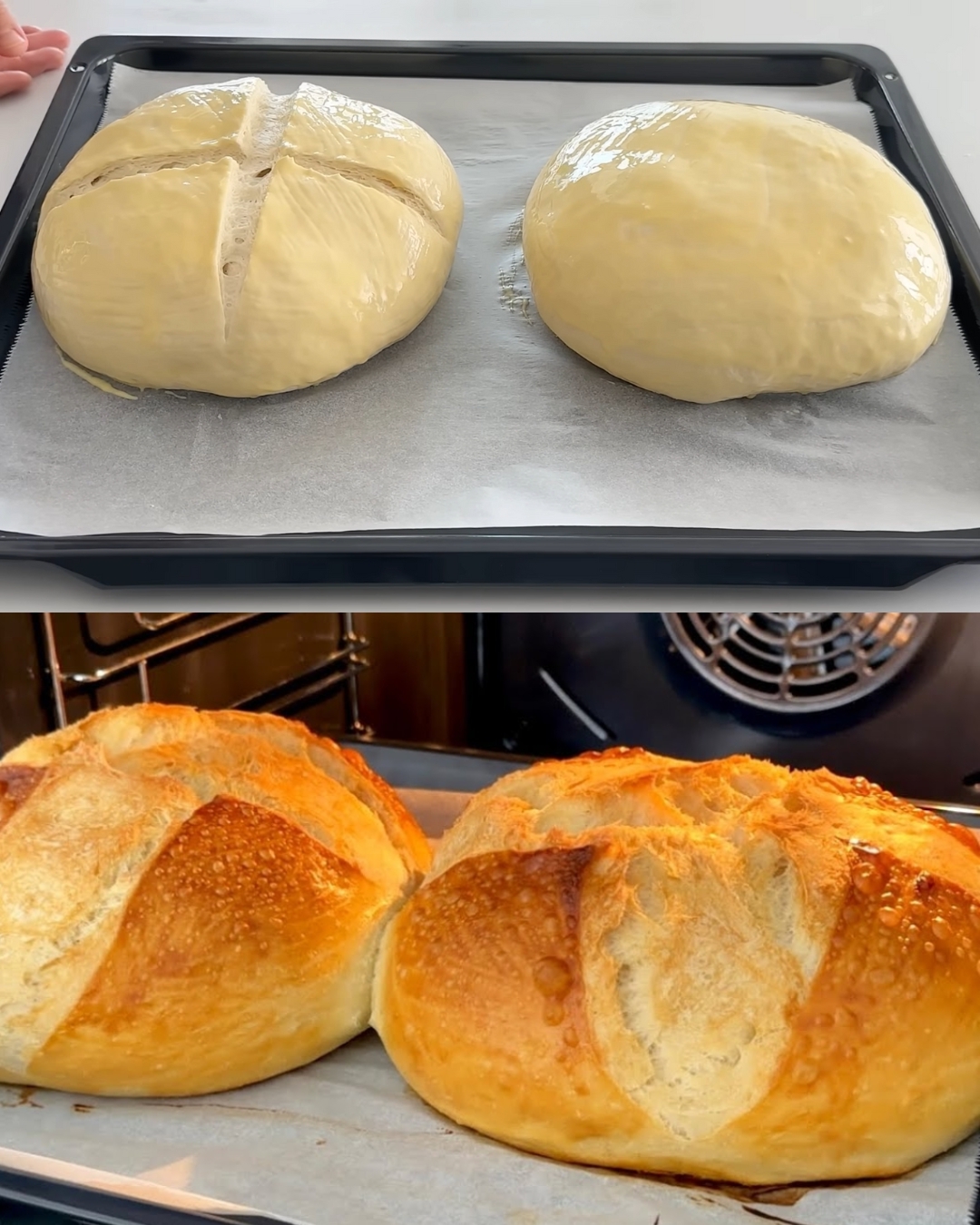This homemade bread delivers a perfectly crispy crust and a soft, airy interior, making it a versatile addition to any meal of the day. Ideal for breakfast, lunch, or as a side to dinner, this bread is not only easy to make but also fills your kitchen with a wonderful aroma.
Preparation Time: 15 minutes (plus 15 minutes of resting)
Cooking Time: 25-30 minutes
Total Time: Approximately 1 hour
Servings: 12 slices
Advertisement
Ingredients:
- 10 grams (1 packet) dry yeast
- 200 ml (1 glass) warm water
- 720 grams (6 cups) all-purpose flour + 120 grams (1 cup) for initial mixing
- 10 grams (1 teaspoon) salt
- 1 egg yolk
- 1 tablespoon milk
Directions:
- Activate the Yeast:
- Dissolve the dry yeast in warm water, stirring until fully dissolved.
- Mix the Dough:
- Add 120 grams of flour to the yeast mixture and stir until smooth.
- Gather the dough, cover it, and let it rest for 15 minutes.
- Knead the Dough:
- After resting, mix in 400 ml of warm water.
- Gradually add the remaining 720 grams of flour and salt, kneading for 3-4 minutes until a soft, slightly non-sticky dough forms.
- Ferment:
- Cover the dough and let it ferment in a warm place until it doubles in size (about 1-2 hours).
- Once risen, remove air from the dough, gather it, and divide it into two equal parts. Roll each part into a ball and let rest for 10 minutes.
- Shape the Dough:
- Lightly flour the surface, expand each dough ball with your fingers, then roll it inward. Repeat with the second dough ball.
- Second Rise:
- Arrange the shaped dough on a baking tray, cover, and leave for 20 minutes.
- Prepare for Baking:
- Preheat the oven to 200°C (392°F).
- Brush the dough with a mixture of egg yolk and milk.
- Bake:
- Bake in the preheated oven for 25-30 minutes or until the bread is golden brown.
Serving Suggestions:
- Serve warm with butter or your favorite spread.
- Perfect alongside soups, salads, or as a base for sandwiches.
Cooking Tips:
- Ensure the water is warm, not hot, to activate the yeast properly.
- Avoid over-kneading the dough to maintain a soft and light texture.
- If the dough is too sticky, add a little more flour as needed.
Nutritional Benefits:
- Provides a good source of carbohydrates for energy.
- Homemade bread typically contains fewer preservatives compared to store-bought options.
Dietary Information:
- Contains gluten due to the flour.
- Suitable for vegetarians.
Nutritional Facts (per serving):
- Calories: 150
- Total Fat: 1.5g
- Saturated Fat: 0.5g
- Cholesterol: 20mg
- Sodium: 300mg
- Total Carbohydrates: 30g
- Dietary Fiber: 1g
- Sugars: 1g
- Protein: 4g
Storage:
- Store in an airtight container at room temperature for up to 3 days.
- For longer storage, freeze in a resealable bag for up to 3 months. Thaw at room temperature or warm in the oven before serving.
Why You’ll Love This Recipe:
- Easy to follow with simple ingredients.
- Produces bakery-quality bread at home.
- Versatile for various meals and occasions.
- The bread is soft on the inside and crispy on the outside.
Conclusion:
This homemade bread is a fantastic addition to any meal, offering a delightful texture and flavor. Its simplicity and delicious outcome make it a go-to recipe for bread lovers. Try it out, and you’ll find yourself making it regularly. Enjoy the fresh-baked goodness with your favorite dishes!
Frequently Asked Questions:
- Can I use instant yeast instead of dry yeast?
- Yes, instant yeast can be used directly without dissolving in water.
- What if my dough doesn’t rise?
- Ensure your yeast is fresh and the water is warm enough. If it’s still not rising, it might be due to a cold environment.
- Can I use whole wheat flour instead of all-purpose flour?
- Yes, but the texture might be denser. You may need to adjust the water amount.
- How do I know when the bread is fully baked?
- The bread should be golden brown and sound hollow when tapped on the bottom.
- Can I add herbs or cheese to the dough?
- Absolutely! Add them during the kneading process for extra flavor.
- How do I prevent the bread from being too dry?
- Avoid overbaking and ensure your dough has enough moisture.
- Can I make this recipe with a bread machine?
- Yes, follow your bread machine’s instructions for mixing and baking.
- What’s the best way to thaw frozen bread?
- Thaw at room temperature or warm in the oven for a few minutes.
- Can I use milk instead of water?
- You can use milk, but it will result in a slightly denser bread.
- How long should I let the dough rise?
- The dough should double in size, which usually takes about 1-2 hours, depending on the temperature.

